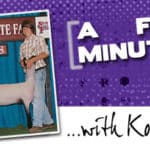
This weeks edition of “A Few Minutes” is with the upcoming American Royal Market Lamb judge Kelly Bruns. Kelly currently resides in Brookings, South Dakota and is a professor in Animal Science with a teaching appointment at South Dakota State University. His family consists of wife, Stacie, and their three boys, ages eight, six, and four.
What do you believe is the most important priority in evaluating market lambs?
I put a great deal of emphasis on selecting a complete lamb that is structurally correct without necessarily any extremes in one given area.
When you get down to those two or three top end lambs in a class, what decides between those lambs?
At that point I put emphasis on muscle shape in their top – rack and loin. If they all have a desirable shape then I put emphasis on the lamb that is better in their design being smoother through their shoulder and not overly coarse. I appreciate lambs that have the ability to move correctly.
A lot of emphasis has been put on bone in the market lamb industry lately. What are your thoughts on putting such emphasis on this?
I judge steers as well, so in context to the cattle industry, they have taken bone to such extremes that it has resulted in calving difficulties which is out of line with the production aspects of the cattle industry. They just simply took it too far and it’s tough to break away from that. For the sheep industry, greater emphasis has been good, because lambs needed to be stouter with more production traits. As long as breeders and judges don’t take it too far, making them too large jointed and coarse.
What do you consider to be an acceptable amount of back fat?
The changes that have taken place in selecting lambs that have a stouter appearance with more rib has resulted in lambs that have more cover than several years ago. This increase has helped the fleshing ability and longevity of many replacement ewes. Based on my experience evaluating carcasses an acceptable range in my mind would be near .20 of an inch of back fat.
What classes do you teach at SDSU?
I currently teach Introduction to Animal Science as well as a Livestock Marketing and Evaluation course that includes carcass evaluation.
What is one thing you hope kids take out of their show experience?
As times change, the skills that we hope showing livestock develop change. Skills such as gaining a greater appreciation for agriculture are becoming a higher priority. With my own family, I hope to develop skills on selection, care, and feeding as well as the ability to meet and communicate effectively with their peers. One of the greatest characteristics they are gaining is a greater appreciation for difference of opinion. As we breed, select, and raise projects our priorities will not match up with everyone we show under or against. Understanding and accepting these differences will probably be the greatest life skill they can gain as they enter their careers and quickly learn that not everyone has the same thoughts, priorities or values.
Who was the most influential person/or people in getting you started in the sheep industry/judging?
I have to give credit to the students on my judging teams as they consistently did well placing and giving reasons on market lamb classes. Their abilities captured the attention of officials at the national contests who have suggested my name to show management.
What is your background in the sheep industry?
I grew up with a small flock of Hampshire cross club lamb style ewes that I used to generate lambs for me to show at the county and state level. I maintained these ewes for several years until I started working on my Ph.D. When the boys were born, we decided to get some Southdown ewes for them. Southdowns have give them a chance to compete in the breeding shows at the state and national level, as well as the ability to exhibit them in market lamb shows. What we liked about the Southdowns, was we could compete in both facets with basically the same set of sheep. Having a purebred breed also gives the boys the opportunity to be part of a breed association.
Here are a few fun questions!
What is your favorite book?
In a class I teach, the class participates in a common read of a book across campus. One of these books which has made a lasting impression on me was “Mountains beyond Mountains” a biography of Dr. Paul Farmer who first established hospitals in Haiti but now has built hospitals in South American and Africa under Partners in Health. Dr. Farmer is truly a unique individual who has devoted his life to helping the underserved.
Who was your favorite band growing up?
In college I gained an appreciation for classical rock. Surprisingly my kids like it to, something my mother probably would not approve of.
















